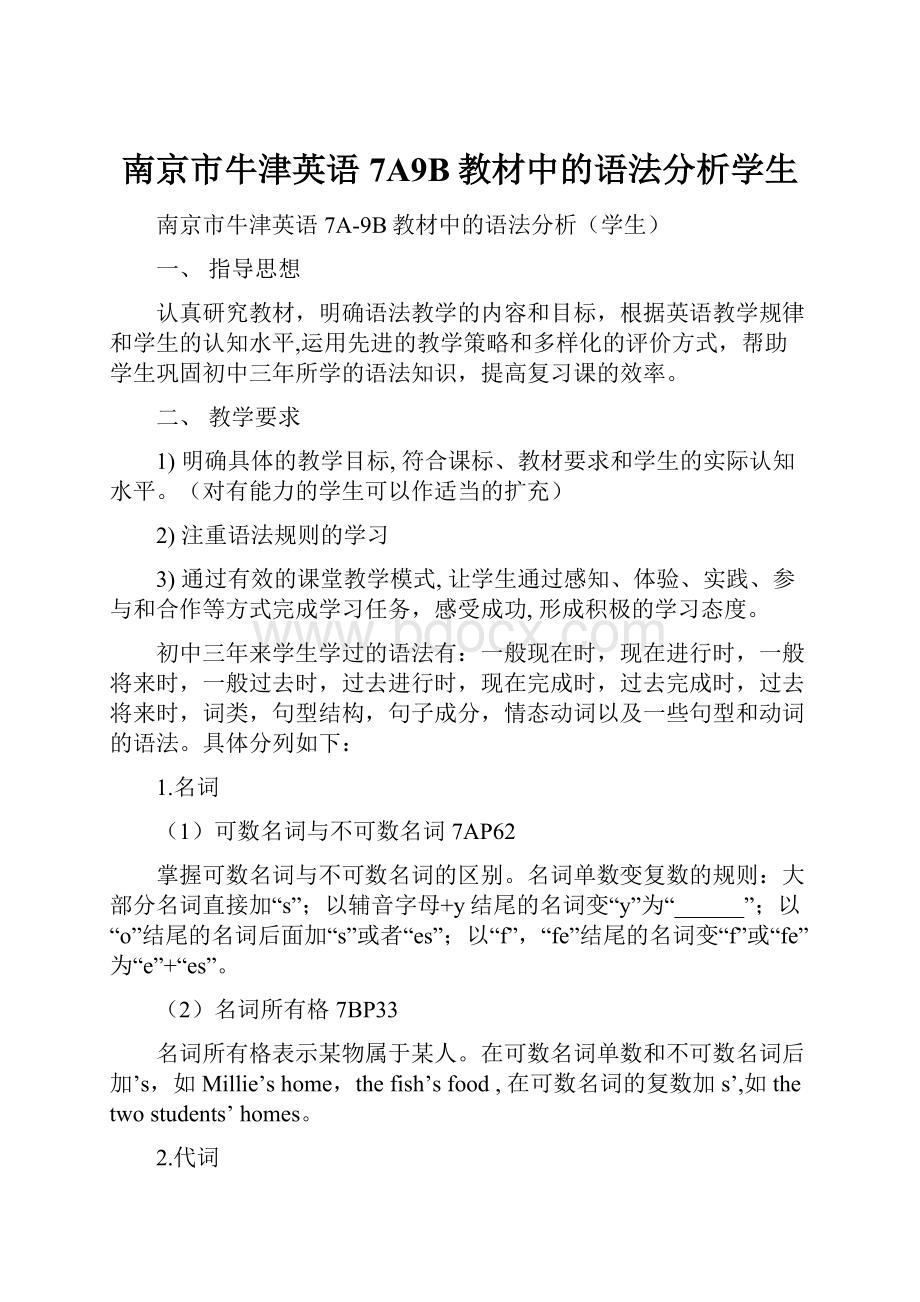南京市牛津英语7A9B教材中的语法分析学生.docx
《南京市牛津英语7A9B教材中的语法分析学生.docx》由会员分享,可在线阅读,更多相关《南京市牛津英语7A9B教材中的语法分析学生.docx(25页珍藏版)》请在冰豆网上搜索。

南京市牛津英语7A9B教材中的语法分析学生
南京市牛津英语7A-9B教材中的语法分析(学生)
一、指导思想
认真研究教材,明确语法教学的内容和目标,根据英语教学规律和学生的认知水平,运用先进的教学策略和多样化的评价方式,帮助学生巩固初中三年所学的语法知识,提高复习课的效率。
二、教学要求
1)明确具体的教学目标,符合课标、教材要求和学生的实际认知水平。
(对有能力的学生可以作适当的扩充)
2)注重语法规则的学习
3)通过有效的课堂教学模式,让学生通过感知、体验、实践、参与和合作等方式完成学习任务,感受成功,形成积极的学习态度。
初中三年来学生学过的语法有:
一般现在时,现在进行时,一般将来时,一般过去时,过去进行时,现在完成时,过去完成时,过去将来时,词类,句型结构,句子成分,情态动词以及一些句型和动词的语法。
具体分列如下:
1.名词
(1)可数名词与不可数名词7AP62
掌握可数名词与不可数名词的区别。
名词单数变复数的规则:
大部分名词直接加“s”;以辅音字母+y结尾的名词变“y”为“______”;以“o”结尾的名词后面加“s”或者“es”;以“f”,“fe”结尾的名词变“f”或“fe”为“e”+“es”。
(2)名词所有格7BP33
名词所有格表示某物属于某人。
在可数名词单数和不可数名词后加’s,如Millie’shome,thefish’sfood,在可数名词的复数加s’,如thetwostudents’homes。
2.代词
(1)人称代词7AP24-25
掌握人称代词的主格形式以及它在句子中做主语的用法。
学生能够根据上下文的语境推测出正确的代词。
7AP79
掌握人称代词的宾格形式。
学生能够正确写出人称代词单、复数以及主格、宾格的形式。
人称
单数
复数
主格
宾格
主格
宾格
第一人称
I
________
we
________
第二人称
you
you
you
you
第三人称
he
______
they
_______
she
her
it
it
(2)物主代词7BP34
形容词性物主代词和名词性物主代词表示某物属于某人/某物
I
my
toys
You
love
your
We
our
They
_________
He
loves
his
She
her
It
_________
Theyare
______.
yours
ours
theirs.
his.
_______.
(4)疑问代词7AP43-44
掌握用“wh-”疑问词提问并回答。
疑问词“________”对活动或事物提问;“which”对事物或人提问,着重强调哪一个;“who”对人提问;“whose”对所有物提问;“________”对时间提问;“where”对地点提问;“why”对原因提问;“________”对方式提问。
(3)不定代词7AP45
能正确使用“some”和“any”来讨论东西的数量。
“some”用于肯定句和表示请求和提供建议的句子中;“any”用于否定句和疑问句。
9AP29-P31
正确使用不定代词:
修饰不定代词的定语放在它们的后面;不定代词做主语时,后使用单数谓语动词。
(5)8AP44-45
掌握反身代词的用法,当主语和宾语为同一人时用反身代词。
I,you(你),you(你们),we,they,he,she,it相对应的反身代词是myself,yourself,________,ourselves,_________,herself,itself,________。
3.数词
(1)基数词7BP14
帮助学生掌握基数词在表示数量的用法和读法。
e.g.
1
2
3
4
5
6
7
8
9
one
two
three
four
five
six
________
eight
nine
10
11
12
13
14
ten
eleven
________
thirteen
fourteen
15
16
17
18
19
fifteen
sixteen
seventeen
eighteen
_________
20
30
40
50
60
70
80
90
twenty
thirty
forty
_______
sixty
seventy
eighty
ninety
100
1000
10000
one________
one__________
tenthousand
100,000
1,000,000
onehundredthousand
one__________
(2)序数词7BP16-17
帮助学生掌握序数词在表示日期,楼层,结果等的用法以及和基数词的相互变化。
one
two
three
four
five
six
________
________
third
forth
fifth
sixth
seven
eight
nine
ten
eleven
twelve
seventh
eighth
________
tenth
eleventh
________
thirteen
twenty
twenty-one
twenty-two
twenty-three
thirty
thirteenth
________
twenty-first
twenty-second
twenty-third
thirtieth
4.介词
7BP13方位介词:
帮助学生掌握方位介词:
infrontof,between,nextto,between,opposite,on在表示方位得用法。
infrontof表示在前方,但是不在范围内;between常与________连用,表示在之间;next________表示在隔壁;opposite表示在对面;on表示在上面而且接触。
e.g.
Welovetosit________thefloor.
Thehouseisoverabridge.
Simonsits_____________Kitty.(在……前面)
Kittysits________toSandy.
7BP48动作介词:
across表示.从平面横过.越过,along表示.沿着,和……一起,________表示.从内部穿过,over表示垂直在上,to表示方向,up表示向上,到(较高的地方去),down表示向下,到(较低的地方去),________表示围绕,在周围,from常与________连用。
表示从……到(表示间或地点)。
7AP41-42
1)掌握表示时间的介词“at”,“in”,“on”的用法。
介词“at”用于具体的点钟、一日三餐、节日和年龄之前;介词“________”用于一周七天、日期之前及某天的上午下午和晚上;介词“in”用于月份、季节、年和一天中不同部分之前。
如:
________six,onSundays.
9AP65-P67
掌握用between…and…、from…to…、before、after、until、while和as表达事情发生的时间
5.连词
8AP41-43
掌握and,but,or(或者)的用法,and表示并列,________表转折,________表示可能性或选择。
e.g.
Theskywasblue________everythingwasbeautiful.
Thepyramidsweresmallbutlookedjustliketherealones.
Wecangotherebycoach________metro.
8AP95-96
掌握表示原因的连词的用法:
because,as,since.(这些词放在句子前面或中间,主句不能再用so.)
Reason
Thechildrencried
because
as
since
theywerefrightened.
Reason
Because
As
Since
thechildrenwerefrightened,
theycried.
6.形容词(比较级与最高级)
8AP8-10
1)掌握描述性形容词的用法。
此类形容词用来描述某人或某物,放在名词前或联系动词后。
e.g.
Shehasshorthair.
_______hairisshort.(她的)
2)掌握形容词的比较级和最高级的变化规则和用法。
规则变化一般情况加er,以e结尾加r/st,以辅音字母+y结尾改y为ier/iest,重读闭音节结尾的双写尾字母再加er/est,部分较长的形容词加____________构成比较级;不规则变化中记住good-________-________,bad-________-________,many-________-________。
比较级是用来比较2个/类人或事物的,而最高级是用来比较3个/类人或事物的。
e.g.
Sandy’shairis________thanMillie’shair.(long)
Mybookis________interestingthanhisbook.
Heisthe________boyinhisclass.(tall)
Thisisthemostexpensiveprinterintheshop.
P10-11
掌握表示“比较”的句式,as+形容词+as-----“和……一样”,notas/so+形容词+as——“……不如……”e.g.
Millieisas________asKitty.(tall)
AmyisnotastallasPeter.(AmyisshorterthanPeter.)(PeteristallerthanAmy.)
P24-27
1)比较两者间的数量用以下句式:
more….than,fewer….than.,less…than.e.g.
Ihavemore/fewerapplesthanyou.(后跟复数名词)
Ihavemore/lessfreetimethanhe/him.(后跟不可数名词)
2)比较两者以上间的数量用themost,thefewest,theleast.e.g.
Amyscoredthemost/fewestpointsofall.
Danielhastheleastmoneyofthethree.
7.副词(比较级与最高级)
7AP60-61
掌握表示频率的副词“never”,“seldom”,“often”,“usually”,“always”的含义,对他们提问要用“How________(多长时间一次)”
8AP79-81
我们可以用方式副词来进一步描述事情发生的方式,句中一般用来修饰动词(词组),往往由形容词+ly变成副词,以le结尾加y,以辅音字母+y结尾改y为ily.部分不规则变化,如good变________,少数副词和形容词同形,如:
fast,early,long等。
e.g.
ShespeaksfluentEnglish.ShespeaksEnglishfluently.
Heisalwaysvery________whenshedrives.Hedrives________.(careful)
9AP68-P69
掌握副词的比较级和最高级
8.冠词
7AP63
掌握不定冠词“a”,“an”用于可数名词之前的用法;掌握不定冠词“a”,“an”用于不可数名词之前表示他们的数量。
e.g.
Thereis________appleandsomepearsonthetable.
Iwanttobuyanorange.
aglassofwateracupoftea
7BP35
定冠词the的用法表示独一无二的或前面已经提过的事物。
e.g.
SunshineTownisanewtowninBeijing,thecapitalofChina.
Thereisacountrypark.________parkisbeautiful.
9.动词
7BP82
1)帮助学生掌握can/could表示“能力”“会”的用法。
can表示有能力做某事,________表示在过去有能力做某事。
e.g.
IcanspeakEnglish.
IcouldswimwhenIwasyoung.
其肯定、否定和疑问形式如下:
I/You/We/He/
She/It/They
can
dance.
cannot/can’t
I/You/We/He/
She/It/They
could
dance
inthepast.
couldnot/________
Can
I/you/we/he/she/
it/they
run?
Yes,
I/you/we/he/she/
it/they
can.
No,
cannot/can’t
Could
I/you/
we/he/it/she/they
swim
lastyear?
Yes,
I/you/we/he/she/
it/they
could.
No,
couldnot/couldn’t
2)帮助学生掌握can/could表示“可能”“可能性”的用法。
相对而言could表示更小一点的可能性。
e.g.
Iamfree.Icanhelpyou.
Atthattime,anythingcouldhappen.
7BP100掌握情态动词should&must的用法
should(应该)/shouldn’t(不应该).e.g.
Youshouldplaywithyourcatforsometimeeveryday.
Youshouldnot/shouldn’tfeedyourpetatthetable.
must(必须)/mustn’t(不可以,不允许).e.g.
Youmustlookafteryourpet.
Youmustnot/mustn’tbringyourpettoschool.
9B掌握用情态动词can,could,may和might讨论允许或许可。
can非正式,用于朋友之间,could正式,用于老师或长者,may正式礼貌,用与和陌生人及尊敬的人之间,might很正式,很有礼貌。
10.动词不定式
8AP43-44
掌握动词+todo的用法,一些动词后面可以加to+动词原型,这些动词有:
plan,agree,want,decide,choose,hope,learn,prepare等。
e.g.
Weplan________Lindaout.(take)
Lindawantedtovisitthepark.
Sandyagreestostayathome.
9AP45-P46
了解和正确使用疑问词what,when,which,who,where,how等和动词不定式连用,why除外,构成不定式短语,它常常与下列动词连用:
know,show,teach,tell,findout,learn,decide,forget,remember.
11.时态
(1)一般现在时7AP8
帮助学生掌握一般现在时表达客观事实,目前存在的事实以及经常做的事情以及它的肯定句、否定句、一般疑问句以及她的肯定与否定回答的结构。
e.g.Thesun________intheeast.(rise)
MyparentsliveinShanghainow.
Mysisteroften________Englishinthemorning.(read)
I/You/They/We
like
Fish
He/she/It
likes
I/You/They/We
don’tlike
Fish
He/she/It
________like
Do
I/you/they/we
like
fish?
Yes,I/you/they/wedo.
No,I/you/they/wedodon’t.
________
he/she/it
like
Yes,he/she/itdoes.
No,he/she/itdoesn’t.
P10-11
!
)掌握第三人称动词的变化形式:
大部分动词后面加“s”;以辅音字母加“y”结尾的动词变字母“y”为“i”,再加“es”;以字母“ss”,“ch”,“sh”或者“x”结尾的动词加“________”。
2)学会一般现在时“tobe”的肯定句,否定句以及一般疑问句
I
am/’m
happy
You/We/They
are/’re
He/She/It
Is/’s
Am
I
happy
Are
You/We/They
Is
He/She/It
Yes,/No,
I
am/amnot.
you/we/they
are/arenot.
he/she/it
is/isnot.
P26-27
掌握一般现在时“todo”的一般疑问句形式及其肯定与否定回答。
Do
I/you/we/they
like
swimming?
Does
he/she/it
Yes,
I/you/we/they
do
he/she/it
________.
No,
I/you/we/they
________
he/she/it
________.
(2)一般过去时7AP93-95
1)掌握一般过去时的定义:
表示过去发生的动作或存在的状态。
它经常与ago,twoweeksago,lastweek,yesterday,lastnight,yesterdayevening等词连用。
2)掌握动词过去时的构成方式:
大部分动词后面加“ed”;以“e”结尾的动词后面加“d”;辅音字母加“y”的动词变“y”为“i”+ed;如果动词以重读、闭音节结尾,且末尾只有一个辅音字母,应先双写这一字母,再加-ed。
7BP66-69
1)帮助学生掌握一般过去时在表示过去发生的事情的用法。
实义动词的一般过去时的变化一般加ed,以e结尾加d,辅音字母+y结尾把y改为ied,重读闭音节结尾的双写再加ed。
e.g.
LastSundaymorning,MillieandAmy________toSunshinePark.(go)
Yesterdaymorning,theywentthereagain.
2)掌握一般过去时肯定、否定和疑问形式。
I/You/WeHe/She/
It/They
heard
awhisper.
I/You/We/He/She/
It/They,
didnot/didn’t
hear
awhisper.
________
I/You/We/
He/She/
It/They
hear
awhisper?
Yes,
I/You/We/
He/She/
It/They,
did.
No,
didnot/________.
掌握be动词的过去式:
was/were及其肯定、否定和疑问形式。
I/He/She/It
was
athomeyesterday.
You/We/They
were
I/He/She/It
wasnot/wasn’t
athomeyesterday.
You/We/They
werenot/________
Was
I/he/she/it
athomeyesterday?
Were
you/we/they
No,
I/he/she/it
wasnot/wasn’t.
you/we/they
werenot/weren’t.
Yes,
I/he/she/it
was.
you/we/they
were.
(3)一般将来时7BP49-51
帮助学生掌握一般将来时在表示即将发生的事情和制定计划时的用法以及3种如下的结构:
will+动词原形,shall+动词原形(但只能用于we/I第一人称),is/am/aregoingto+动词原形。
e.g.
Theywillseeus.
________wetakedifferentroutes?
Iamgoingtotakeanotherroute.
I/We
will(not)/shall(not)
Go.
He/She/It/You/They
will(not)
Will/Shall
I/we
Go.
Will
he/she/it/you/they
Yes,
I/we
will/shall.
he/she/it/you/they
will.
No,
I/we
will/shallnot.
he/she/it/you/they
________.
e.g.
She_________visithergrandmothernextFriday.
Wearegoingtowinthegame.
Itissocloudy.Ithinkit_______________